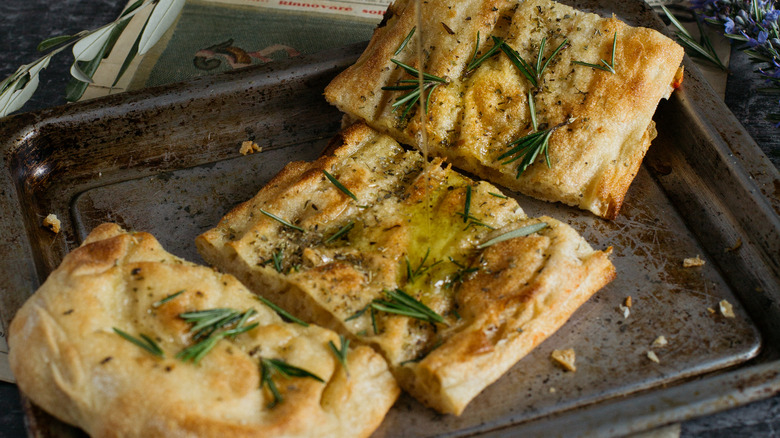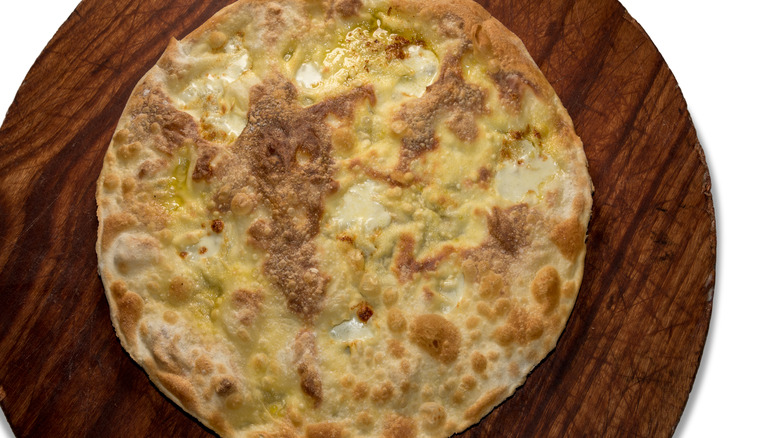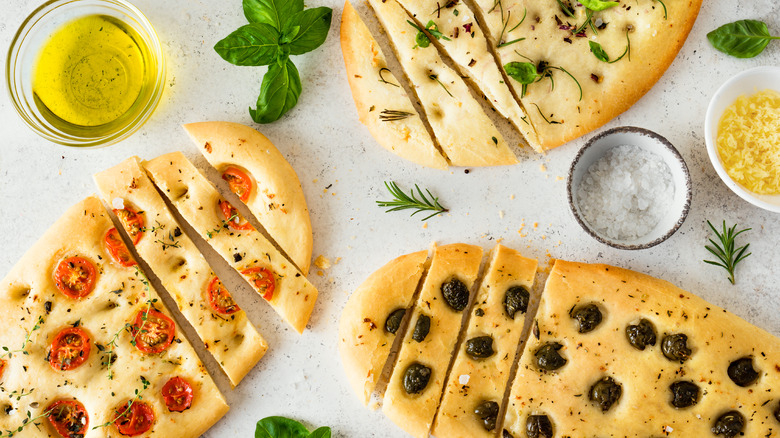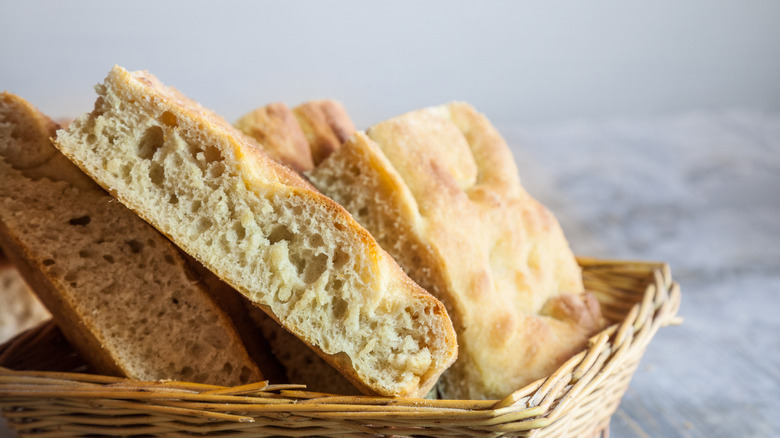How Ligurian Focaccia Became The Gold Standard For Italian Flatbread
The region of Liguria is a long, skinny region in the northwest of Italy. Known for its dramatic coastline and verdant Liguria, it is the picture of what everyone envisions Italy to be. Its main city, Genoa, has birthed some of the most famous Italian culinary creations, such as Genoa salami, linguine, and basil pesto. However, the city and region are perhaps best known for making the best of world one of its most famous flatbreads: focaccia.
Characterized by its golden crust, fluffy interior, and crisp, olive oil-drenched exterior, focaccia has served as the country's chief flatbread since the days of the Etruscans of north central Italy, several thousand years ago. The bread is made with a combination of flour, salt, extra virgin olive oil, and a leavening agent, which is traditionally brewer's yeast. This all comes together in an aerated dough, which is pressed down by the baker's fingers and mottled with individual dimples. The bread is then drenched in more olive oil and salt before being baked in a hot oven. The result is a beautifully crispy exterior and a light, fluffy interior.
This type of focaccia, known as focaccia Genovevse or fügássa, is the kind everyone knows and loves. However, Liguria itself is home to several different types of focaccia, each with a different preparation. These breads have formed the core of the region's cuisine, and have each contributed to the high standard placed on focaccia from the region.
The origins of Ligurian focaccia
Foccacia is believed by many historians to have emerged in Italy sometime during the Etruscan period before the establishment of the Roman Empire. It is likely that the original focaccia was unleavened, directly connecting it to Liguria's oldest focaccia, the Focaccia di Recco. Unleavened means that there is no yeast in the bread, thereby making it flat. Instead, Focaccia di Recco consists of the base ingredient dough of flour, water, and olive oil formed into two very large rings of dough that have been stretched thin. Between the rings are sandwiched dollops of fresh cheese. The two rings are sealed together, doused with olive oil, and baked in the oven until bubbling and crispy.
The first written record of Focaccia di Recco dates back to the 12th century. Local legends, however, speak of ancient Saracen pirates hiding out in the Ligurian hills and making the first Focaccia di Recco with ingredients they could scrounge from the land. As focaccia would eventually evolve into the staple flatbread of dockworkers and fishermen alike, it tracks that its beginnings would be with seafaring pirates. It's also likely the recipe traveled up from neighboring Tuscany, where the Etruscans originally settled.
In 2012, Italy recognized Focaccia di Recco with an IGP or Indicazione Geografica Protteta. This means that the bread has a specific quality and can only be produced in the region. The ancient recipe is thereby protected by government decree, furthering Liguria's position as Italy's top focaccia maker.
Other Ligurian focaccia & regional differences
As there are hundreds of shapes of pasta in one area, so too in Liguria are there different types of focaccia. Though the fügássa is the one that ended up being the most well-known there are a few other region specific specialties that are worth noting for their significance. One of them is the Focaccia di Voltri, which is disk-shaped and made with flour, water, salt, extra virgin olive oil, and brewers yeast. It doesn't rise as much as fügássa, but it does have the same crispy exterior thanks to the olive oil and polenta meal it's coated in.
Other important focaccia from the region include the farinata, which is water, salt, and chickpea flour baked in a sheet. Sardenaria focaccia originates from the town of Sanremo and is made either with anchovies or sardines, both of which proliferate the Ligurian coast.
It is the variety of Ligurian focaccia that makes the region stand out from the other focaccia commonly found across Italy. In Veneto, for example, focaccia is a sweet bread made with butter and sugar instead of olive oil and salt. Focaccia barese, a standard in southern Italy, is made using durum wheat and is traditionally flavored with rosemary, salt, tomatoes, and olives. Tuscan focaccia is heavily dimpled and also comes flavored with lots of herbs and spices. It is, however, the closest relation to fügássa.
Why Ligurian focaccia is the best
By far the most famous of all Ligurian focaccia, focaccia Genovese is considered by many to be the absolute best. Generations of Ligurian fishermen and dockworkers would agree. One of the likely reasons this particular focaccia is so well known is because of Genoa's status as an Italian port. The dockworkers there ate this focaccia practically every day. It was their fuel. As Genoa's reputation as a port grew and it became more busy and exported more goods, the methods for which they made focaccia likely followed. We know this because the way focaccia Genovese is made continues to influence how focaccia is made throughout Italy and the world.
What distinguishes fügássa from the rest of Italian focaccia is just how crispy it is. Just before the final rise, a salt brine is poured over the bread. When the bread enters the oven, the water of the brine steams while the salt crystalizes on the top of the bread. Along with the drenching of extra virgin olive oil, the fugesse becomes extra golden and crispy.
It could also be the variety and the legendary status of focaccia throughout Liguria that gives the region such a reputation. There is no denying, however, that if one wants the best focaccia, the place to go is Liguria. Whether it is the salty and crisp fügássa, the thin and cheesy Focaccia di Recco, or the anchovy covered Sardenaria, there is a focaccia for every taste in Liguria.



